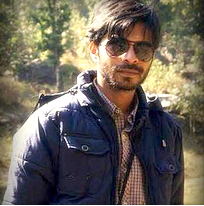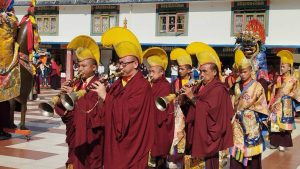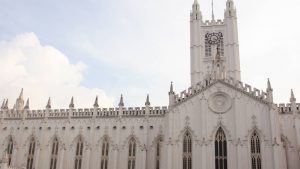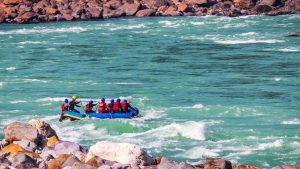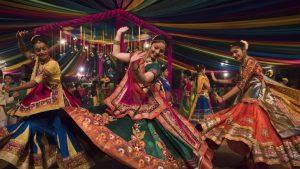Last Updated: September 27, 2019 Swairik Das
I thought “Aghori” in Varanasi is the only unusual ritual in India that is still practised over centuries. It is a way of living by the “Aghori Sadhus” who believe in giving up the world by receiving “chastity in the cruddiest”. But… I was wrong. I forgot that my motherland is a home to a diversified culture that travels from the indigenous tribes in India to Hindu mythology. And it is where a deceptive world with strange rituals, festivals and events lies. It is something that baffles understanding and cannot be explained to the world in general… but acts as a magnetic force pulling in travellers from different corners of the world who seek to trench the cultural trance of India. In this article I have tried to concise some of the most unusual and uncommon festivals and events in India that may be a spark of a traveller’s interest to explore India… THE OTHER WAY.
1. Thaipusam Festival, Tamil Nadu
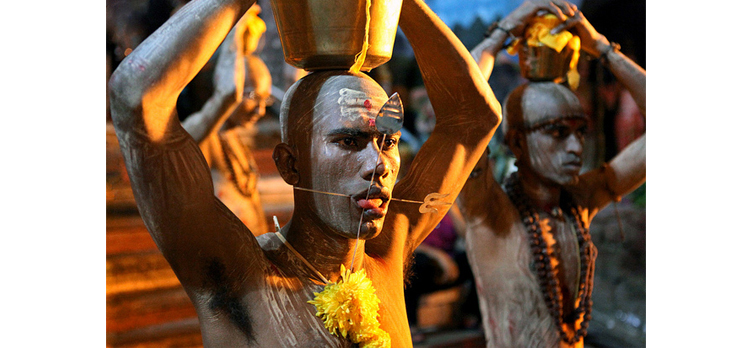
Somewhat similar to the Nine Emperor Gods Festival and Tesagan Gin Je in Southeast Asia, the Thaipusam festival of the Tamil Hindus might be an unusual spectacle of rituals if you are seeing it for the first time. No matter it may also blow you out of the water leaving bubbles of thoughts… resulting in eyes bulging out at the sight of devotees who have their bodies pierced with skewers and hooks. The Thaipusam Festival is one of the unusual festivals in India that is celebrated by the Tamil Hindus in between the months of January and February. It is celebrated to commemorate the occasion of Parvati giving Murugan a Vel “spear” to fight against the evil demon “Soorapadman”. Devotees participating in the Thaipusam festival prepare themselves by cleansing themselves through prayer and long days of fasting and thereafter piercing their bodies. In India it is mostly celebrated in Palani in Tamil Nadu and is also the best time to experience the Kavadi cavadee Attam, which is one of the local dance forms of the south Indians.
Time of the year: Feb 08, 2020
Venue: Palani
2. Jallikattu, Tamil Nadu
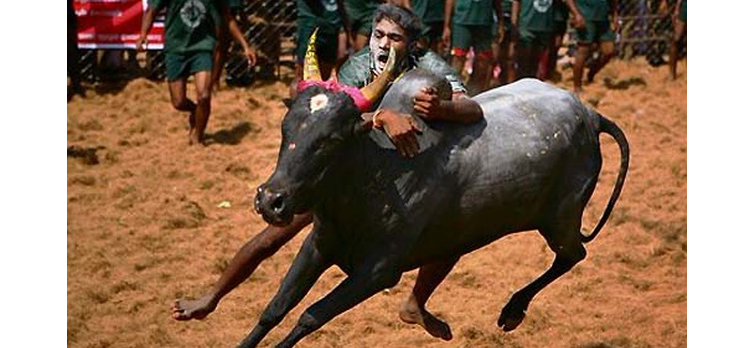
It reminds me of “tauromachy” in Spain. An Indian festival, Jallikattu is a bull-taming sport that is a part of Pongal celebration and is held from January to July. It can be mostly witnessed in a few towns in Tamil Nadu, like Palamedu and Alanganallur, both close to Madurai, which is a popular pilgrimage destination in south India. Jallikattu is a bull cuddling event that rolled over times from the Sangam period in the 3rd century A.D. This Tamil-style bull cuddling is based on the concept of “flight or fight” and the bulls used in this event are of a specific breed of cattle. Travellers who are keen to be spectators at such an unusual event in India might weigh down now as the Supreme Court banned Jallikattu and bullock cart racing in Tamil Nadu, citing animal welfare issues.
3. Thimithi, Tamil Nadu
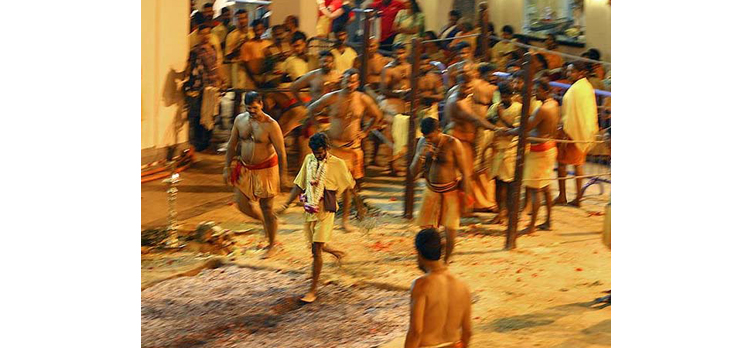
Held in between October and November in Tamil Nadu, the Thimithi festival is another unusual festival in India, and is a firewalking ceremony that is carried out as a religious vow in exchange for blessings from Draupadi, the wife of the five Pandava brothers from the epic Mahabharata. During this auspicious occasion several scenes are enacted by the devotees and drama troupes and in addition ritual performances like an act of imitation of the sacrifice of Hijra, prayers to Periyachi, and bathing the Mariamman with milk… are worth to experience. Prior to the Thimithi festival, there is a silver chariot procession to commemorate the victory of Pandavas.
Time of the year: Oct 20, 2019
Venue: Tamil Nadu
4. Kila Raipur Rural Olympics, Punjab
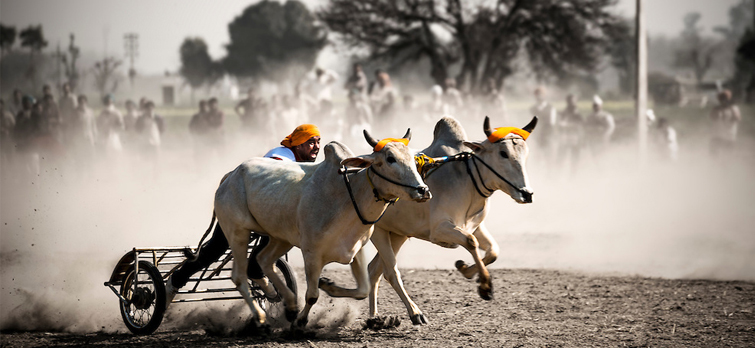
Not that uncommon festival in India, quite popular on its own way… the Kila Raipur Rural Olympics is an event that attracts a huge crowd of sports enthusiasts, including foreigners. It is held annually in between January and February in Kila Raipur, which is close to Ludhiana. The major attractions in the extravaganza are bull cart-race, mule cart race, horse cart race, kabbadi, short put, tug of war, 100mts-1500mts race, high and long jump, and race between tractors. On the other hand this event has played a significant role in the development of tourism in Punjab. One can also witness some other unusual activities like people lifting bicycles or ladders with their teeth; pulling cars with their hair, teeth or ears; and other daredevil stunts on bikes and horses at the Kila Raipur Rural Olympics. If you are also a cultural enthusiast you may decide to stay back for the folk dance and music that is held in the evening… on all three days of the festival.
Time of the year: Jan 22 – 24, 2020
Venue: Ludhiana
5. Puli kali, Kerala
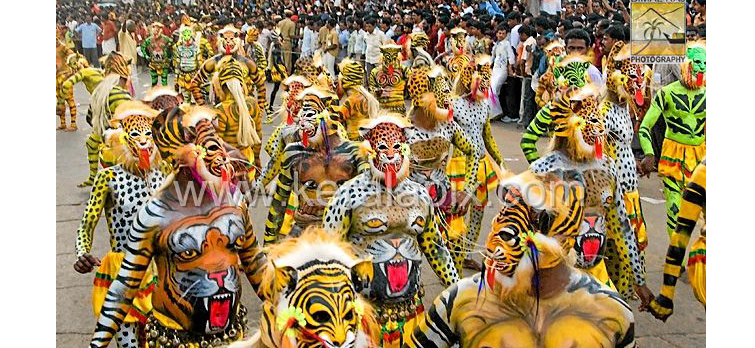
This peculiar event is a major attraction in one of the popular festivals in south India- Onam. Puli Kali is a form of folk art, dance, music and drama that depicts the theme of tiger hunting. Performers are painted like tigers and hunters in yellow, red and black… and they enact their roles to the beats of instruments like Udukku and Thakil. Puli Kali is said to have originated over 200 years back when a Maharaja of Cochin decided to celebrate Onam retracing the wild and macho spirit of the force. Today Puli Kali is a striking feature of Onam where performers dress up in readymade masks, cosmetic teeth, tongues, beards and mustaches. This grandeur is organized by the Pulikkali Co-ordination Committee that was formed in 2004 and is held in the streets to the Swaraj Round, Thrissur.
Time of the year: August – September
Venue: Thripunithara, Kochi
6. Nag Panchami, All over India
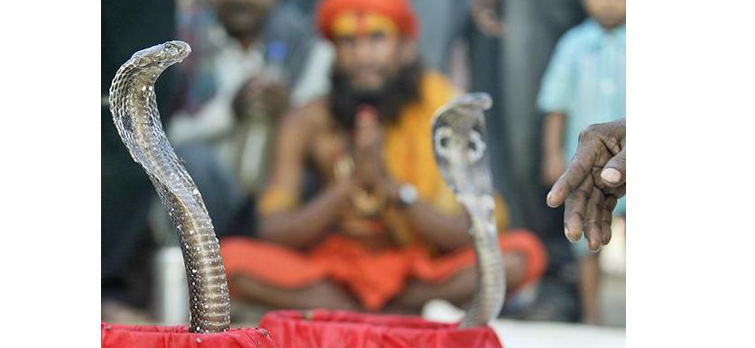
Quite a popular festival in India but is one of the unusual among the international travellers… Nag Panchami is a traditional Hindu festival where snakes or serpents are worshipped and ritualistic performances like bathing the idol of a serpent (made out of silver, wood or stone) with milk takes place. This strange event is mostly held in the rural regions in India in between July and August. In some villages the devotees indulge in live Cobra worships… which counts as a major interest for any traveller who is there to experience the phenomenon. According to Hindu mythology and folklore, there are several legends behind worshiping snakes. Some says that Kadroo, wife of Kashyapa (son of Lord Brahma) gave birth to Nagas and some, according to Mahabharata, believe that Takshaka, the king of snakes and his remaining race who was saved from decimation by the Sarpa Satra yagna and was followed by the festival Nag Panchami. To witness this unusual event, you may step in places like Nagpur in Maharashtra, Panchmarhi in Madhya Pradesh, Varanasi in Uttar Pradesh, and some rural areas in Rajasthan, Punjab, Gujarat, Orissa and West Bengal.
Time of the year: Jul 25, 2020
Venue: Nagpur and Varanasi
7. Madai festival, Chhattisgarh
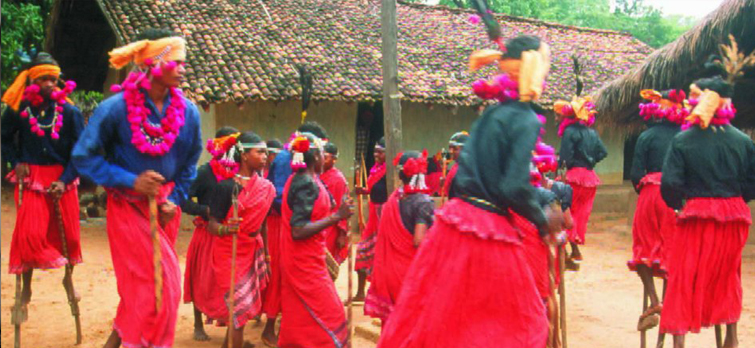
Despite being a popular tribal festival in Chhattisgarh, Madai Festival on the other hand is little known to people from other parts of the country. The Madai festival, in which various ritualistic performances like folk dance and music, prayers, and sacrifice of goats takes place, is dedicated to goddess Kesharpal Kesharpalin Devi, one of the tribal deities,. During the festival one can witness a bright gala affair with shops and eateries… where one can shop for several tribal handicrafts and relish some unique cuisine. The festival is mostly held in Kanker, Bastar and Dantewada regions from December to March each year and Narayanpur village (in February) is the best place to visit during the Madai festival.
Time of the year: December to March
Venue: Kanker, Bastar and Dantewada
8. Bhagoriya Festival, Madhya Pradesh
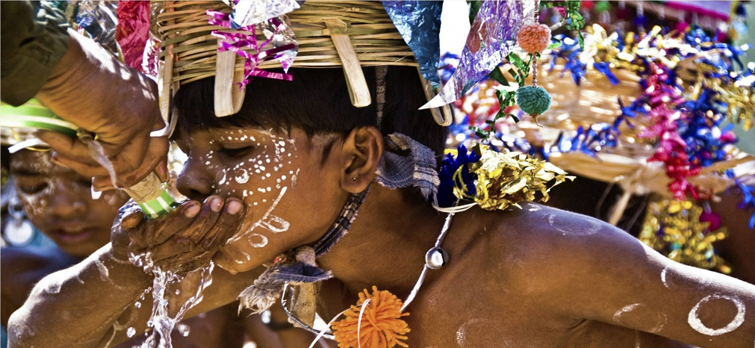
This one is markedly different from any other festivals in India that is held before the Holi festival. The Bhagoriya festival, organized in the district of West Nimar(Khargon) and Jhabua, is all about a particular form of tribal marriage where young boys and girls are allowed to elope after choosing their partners. During this festival of Bhil and Bhilala tribes the boy puts red powder on the face of the girl whom he wants to marry and if the girl is willing to marry that boy she puts the same red powder on the boy’s face… incase the girl refuses, the boy is given another chance to persuade her and win her heart.
Time of the year: February/March
Venue: West Nimar and Jhabua
9. Mim Kut festival, Mizoram
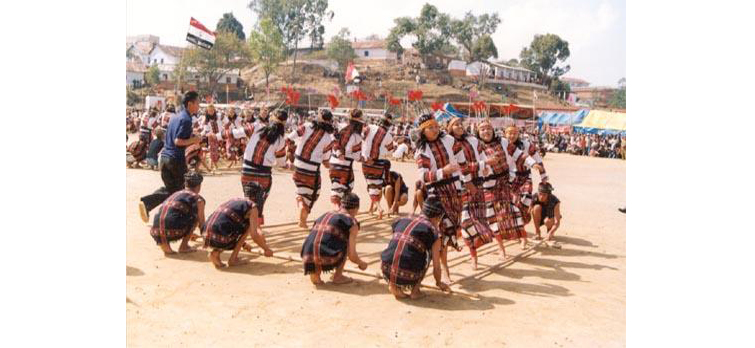
Celebrated amidst huge gaiety, the Mim Kut festival is a harvesting festival in Mizoram that is held in between August and September, after the harvest of maize. The Mim Kut festival is a colourful and musical fiesta where various folk performances become one of the major attractions for the travellers. During this festival one can even try out a hearty tribal meal and sip mugs of local beer made out of rice. Some other tribal festivals in Mizoram are the Chapchar Kut, Thalfavang Kut, and Pawl Kut.
Time of the year: August/September
Venue: Parts of Mizoram
10. Sekrenyi Festival, Nagaland
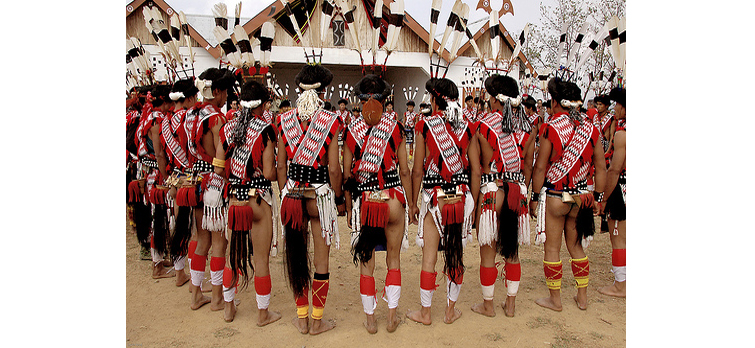
You must have heard of the popular Hornbill Festival of the Naga tribes… but the Sekrenyi festival, which is a harvesting festival of the Angami Naga’s sounds interesting too. Isn’t it? It is a festival of purification with feasting and singing and is a 10 days of merriment and jamboree in the month of February with several ritual performances like “Kizie” and “Thekra Hie”. During this festival men go for a bath at the village well, which is later cleaned and guarded by two young Angamis till the next morning. Tribal duet songs and folk dance and music are some other major performances by the Angami folks during the Sekrenyi festival. Later there is a bridge pulling, which is one of the significant part of the festival, that allows inter village visits and assure people resuming their work on the fields.
Date: February
Venue: Dimapur and Kohima
11. Tsukhenyie Festival, Nagaland
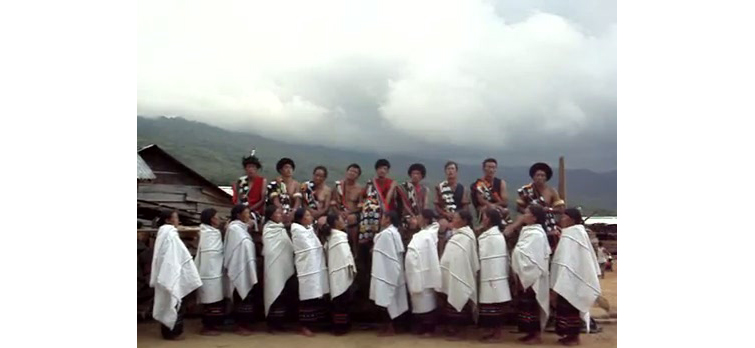
Held in between March and April, the Tsukhenyie Festival is one of the least known tribal festivals in India that is celebrated with great enthusiasm by the Chakhesang Nagas. This festival in North East India is another harvesting festival that is observed to offer thanks for a thriving harvesting season.
Date: March/April
Venue: Kohima
12. Aoleang Festival, Nagaland
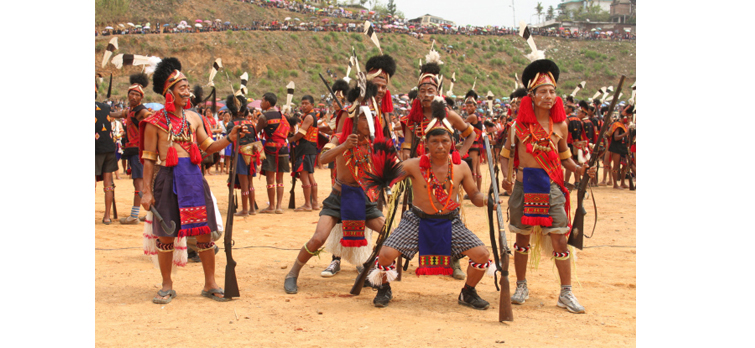
Once deadly headhunters, the Konyak tribe today is one of the indigenous tribes in India who are noted for living a passive lifestyle. Today they are mostly indulging in agriculture, local alcohol, smoking opium, and occasional hunting. The Aoleang festival is a major festival of the Konyak tribe and is celebrated with huge zeal in the month of April to welcome the New Year. This vibrant festival is a rendezvous of people from different parts of North East India and an extravaganza of 6 days. If you are travelling to Nagaland during the Aoling festival… you are surely going to live some of the best unusual and receptive moments of your lifetime along with experiencing traditional culture. During the festival the members of the tribe dress up in beautiful and colorful traditional attires and perform elaborate dances with folk songs. Further there is a gigantic feast consisting of ethnic cuisine along with drinking sessions with the local ‘intoxicating’ rice beer. The Aoleang festival has its own significance each day. On Hoi Lah Nyih the folk spend in collecting firewood and vegetables, weaving traditional attires, and making rice beer. Chicken sacrifice is a part of the ritual where the future is predicted by the shape of the intestine. On the second and third day, locally known as Yin Mok Pho Nyih and Mok Shek Nyih, the young tribal boys are trained to hunt… followed by the spirited and colourful fourth day, Lingnyu Nyih, and the last two days of rendezvous, Lingha Nyih and Lingshan Nyih.
Time of the year: April
Venue: Kohima
13. Moatsu Festival, Nagaland
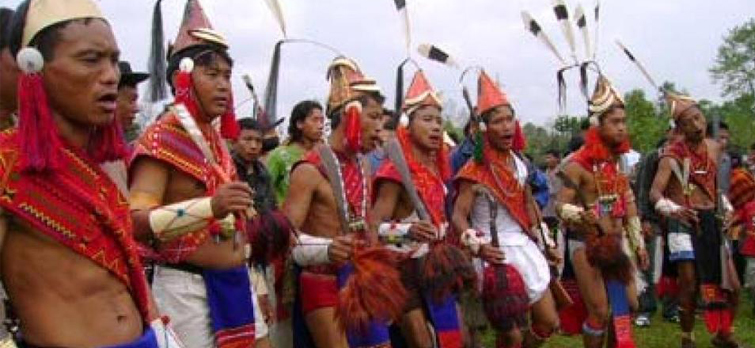
It is a three days of gala affair of the Ao Nagas of Nagaland. The Moatsu festival is yet another uncommon festival in India that is usually held in the month of May in Mokokchung district of Nagaland. It is the time when you can experience the peppy songs and dance and the symbolic celebration of “Sangpangtu”. There are also several other unusual ritualistic performances that ultimately make their way into the word of a traveller’s diary. This festival is observed after the sowing season.
Time of the year: May
Venue: Mokokchung
14. Miu Festival, Nagaland
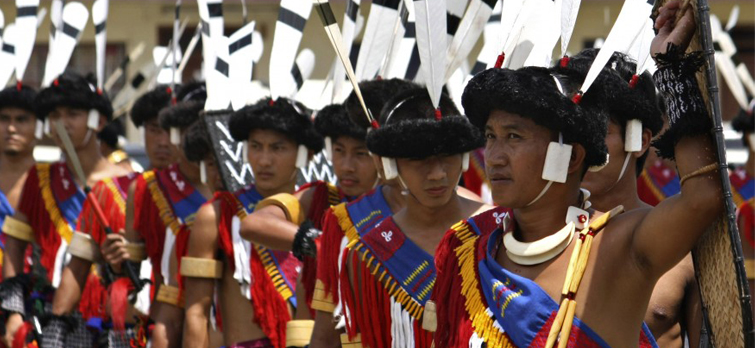
The Miu festival of the Khiamniungan Tribe is quite uncommon for travellers around the world. It is held every year in the first week of May with the significant part of the festival being that it strengthens the bond between an uncle and his nephew/niece. The uncle recites prayers and summons the supernatural deity to bless his nephew/niece with good health, prosperity and the power to trounce their enemies. Another major part of the festival is seedling in the new field and performing pujas by offering animal blood and flesh with other food stuffs to their deity.
Time of the year: May
Venue: Kohima
15. Tuluni Festival, Nagaland
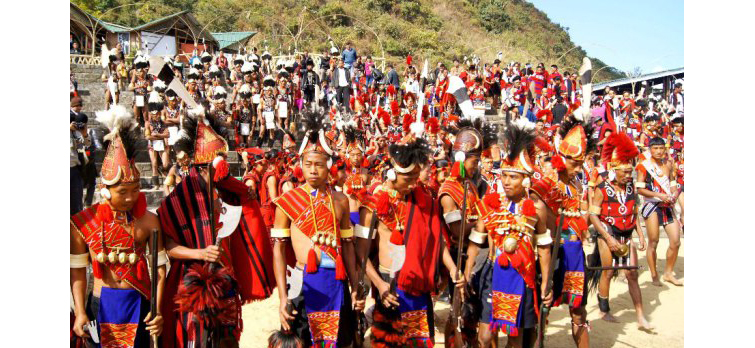
The Tuluni festival of Sumi Naga tribe of Nagaland is celebrated with huge splendor and grandeur to rejoice the season of abundant crops. During this festival devotees offer prayers to Litsaba, a form of tribal deity, who in exchange blesses a fruitful harvesting season. To make the occasion much more vibrant and enthusiastic… the Sumi Naga tribe engages themselves in folk dance and songs as well as lavish meals. Further, the celebration is carried with marriage ceremonials.
Time of the year: July
Venue: Zunheboto district
16. Nazu Festival, Nagaland
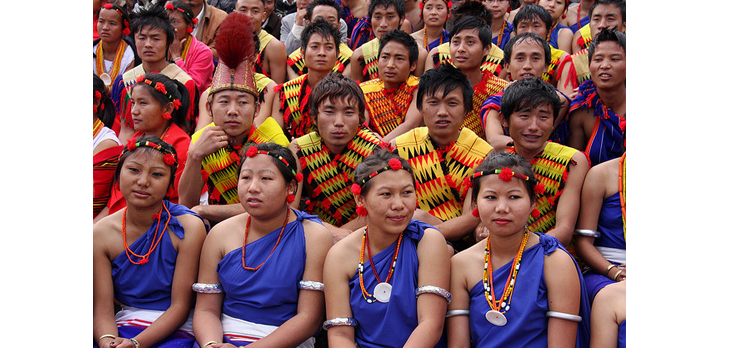
It is a 10 days of glitter and gaiety of the Pochury tribe of Nagaland that is held every year in the month of February. The Nazu festival is more entertaining than it is ritualistic and is the best time to get drenched in the folk dance and music of the festival. The Khupielilie dance, a tribal dance form, is the major attraction in this festival. The dance performers dress up in traditional attires that include Ascunyi, Kiileniinyi, Achulhre, Akhi, Akhusa, and Asker.
Time of the year: February
Venue: parts of Nagaland
17. Metemneo Festival, Nagaland
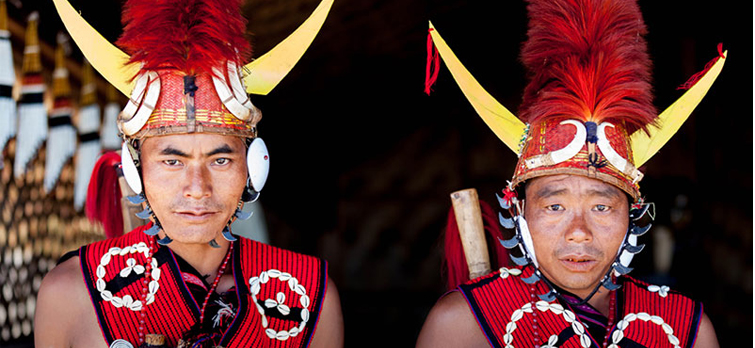
Belonging to the Yimchungers tribe in Nagaland, the Metemneo festival is one of the uncommon festivals in India… which is yet another festival celebrated after the harvest season is over. It is usually during the second week of August when the Yimchunger tribes indulge in various activities like “Sito”, “Shito”, and “Zhimto”, all that is associated with the cleaning of villages and construction of roads; “Chiresco”, which is related to cleaning of water points and springs; and “Siresok”, when the folk assembles for cleaning and worshiping of agricultural tools. The Metumniu festival is a 5 day rendezvous that is a refined example of gusto amongst the indigenous Yimchungers. At the time of the Metemneo festival many social events also take place.
Time of the year: August
Venue: parts of Nagaland
18. Amongmong Festival, Nagaland
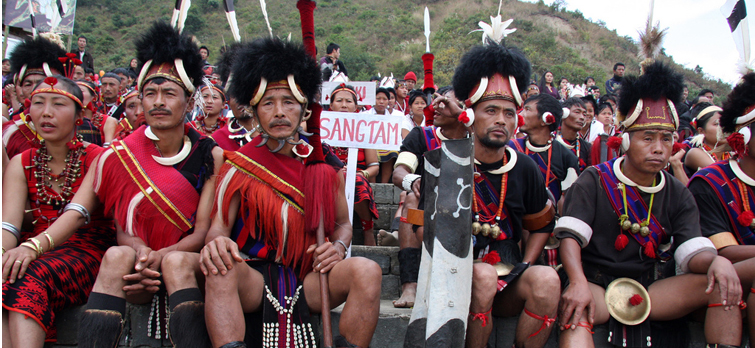
The name itself signifies togetherness. The Amongmong festival of the Sangtam tribes is an annual harvesting festival that is observed with huge vigour, excitement and devotion. It is usually held in the month of September, in the period 1st – 8th, with each day having its own importance. The first three days are followed with the purchase and sale of domestic animals, collection of vegetables, and worship of the resident deities; on the fourth day the members gather for infrastructural development and folk music and dance; on the last two days the villagers visit their family and friends, which is followed by harvesting.
Time of the year: September
Venue: parts of Nagaland
19. Tokhu Emong festival, Nagaland
This is a 9-day post-harvest festival amongst the Lotha Naga tribes of Nagaland. The Tokhu Emong festival is usually held in the month of November signifying brotherhood, forgiveness and oneness. During this festival, the folk participates in worshipping their local deities and stir themselves in local music and dance, exchange food, gifts, folklore narration and a sumptuous community feast. It is the best time to catch a glimpse of the Lotha Nagas in their traditional attire and mood.
Time of the year: November
Venue: parts of Nagaland
20. Ngada Festival, Nagaland and Assam
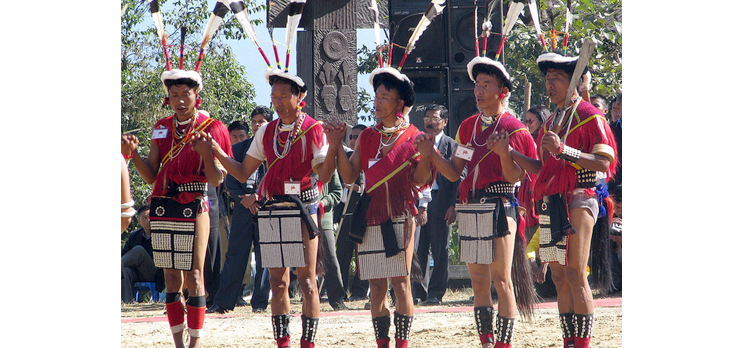
One of the major festivals of the Rengma tribes of North East India, the Ngada festival is a thanksgiving festival that signifies the end of the agricultural season. Each day of the Ngada festival has its own grandness that includes various ritualistic practices; dance, drama and music performances; cleaning of village and reconstructing of roads and making and drinking of rice beer followed by a mouthful feast.
Time of the year: November
Venue: Karbi Anglong district
21. Nga-Ngai festival, Nagaland
The Nga-Ngai festival is yet another thanksgiving festival in Nagaland that is famed amongst the Zeliang tribe and is observed in the month of December every year. Like all other festivals in Nagaland… Nga-Ngai is also celebrated with equal zest.
Date: December
Venue: parts of Nagaland
22. Karama festival, Bihar, Madhya Pradesh and Odisha
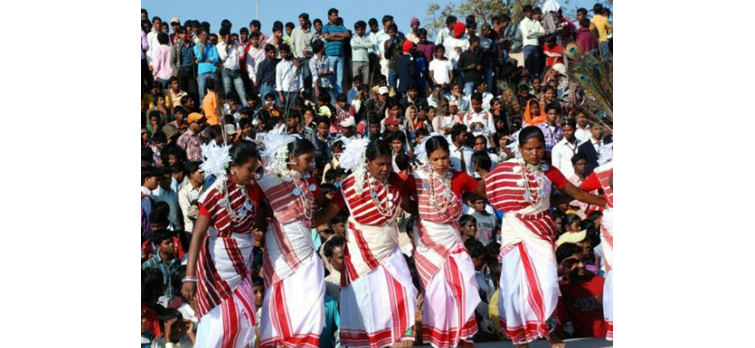
Devoted to goddess Karamasani… the Karama festival is mostly celebrated by the Ho, Kisan, Kol, Bhumij, Oraon, Bhuiyan, and Binijhal tribes of east and central India. The Karama festival is one of the monsoon festivals in India that is followed by various ritualistic practices like worshiping of the branches of a Karma tree in exchange of good wealth and children. The legend behind the Karama festival differs from tribe to tribe. Some legends say that once there were seven brothers and the six elders used to operate a farm while the youngest with his six sisters-in-law was indulge in music and dance round a Karama tree. The elder brothers got agitated and threw away the tree that led the younger brother to leave home in anger. Later their house and farm were cursed but the youngest brother found the Karama tree floating in the river and brought it back. Since then the Karama Devta is being worshipped. Another legend is that a merchant who returned after a successful voyage with wealth threw away the Karama tree as he wasn’t received by his wife and relatives on his return. Later he lost all his wealth which though was restored once again when he brought back the Karama tree from the ocean. The Karama festival is thus one of the major tribal festivals in India having fabled significances.
Time of the year: July/August
Venue: parts of Bihar, Madhya Pradesh, Odisha
23. Sume-Gelirak festival, Odisha
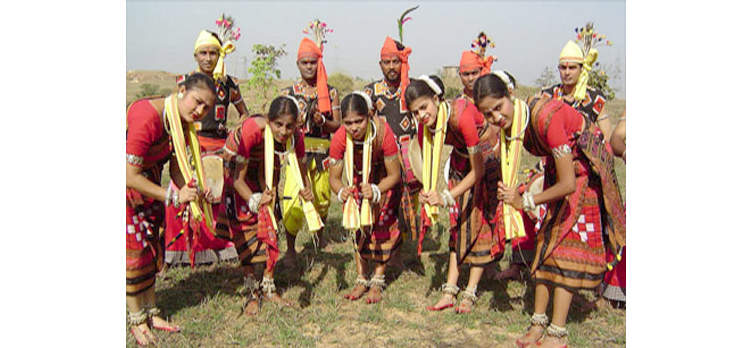
The most important festival of the Bonds of Koraput, the Sume-Gelirak festival in Odisha is a 10-day affair with several ritualistic practices. The ritual of sacrificing animals and birds and appeasing the tribal deities with liquor is one of the significant parts of the Sume-Gelirak festival. The celebration continues with folk dance and songs and it is during this time when you will come across the locals in their traditional attire and musical instruments. The most unique part of the celebration is that during the dance the women can choose their life partners.
Time of the year: Will be updated soon
Venue: Koraput
24. Bija Pandu festival, Odisha
Also known as Chaitra Parva, which is quite common in these parts of east India, the Bija Pandu festival is celebrated mostly amongst the Koya tribes of Koraput in Odisha. Like all other tribal festivals in India, the Bija Pandu festival is dedicated to a resident deity, Gudimata, and includes rituals like sacrificing of animals and birds and propitiating with liquor. During the festival the men goes out for hunting and the women indulge in folk dance and songs throughout the day.
Time of the year: March/April
Venue: Koraput
25. Bohaggiyo Bishu Festival, Assam
It is a weeklong celebration of the Deoris. The Bohaggiyo Bishu festival is one of the captivating spring festivals in Assam that is observed in mid-April. The major attractions for a traveller during the Bohaggiyo Bishu festival are the Deodhani dance form and Husori or Carol song party.
Time of the year: April
Venue: Lakhimpur, Dibrugarh, Sibsagar, and Nagaon
26. Sammakka Saralamma Jatara, Telangana
Also known as Medaram Jatara, the festival is celebrated to honour the fight of a mother and daughter against the unjust law. During the Sammakka Saralamma Jatara, there is a huge gathering of tribal people from different parts of India who devote themselves to the worship of goddesses and offer them gold. The devotees also take a sacred bath in Jampanna Vagu, which is a tributary of the River Godavari. The festival is celebrated over a period of four days and over the last few years it has witnessed millions of people prompting the state government to declare the thousand-year-old festival as official and lay down a motorable road.
Time of the year: February
Venue: Warangal district
27. Dree Festival, Arunachal Pradesh
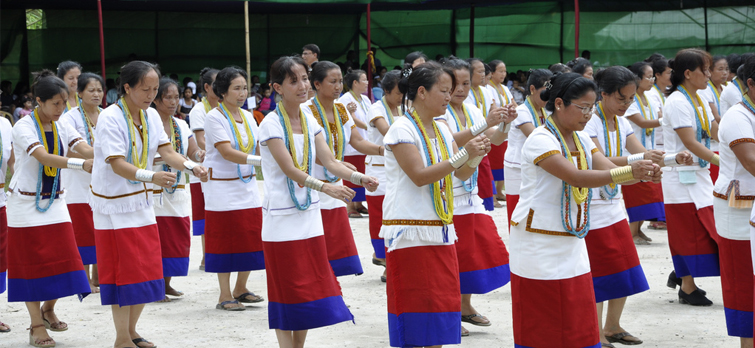
Marked by the sacrifice of animals and birds, the Dree festival of Apatani tribe of Arunachal Pradesh is yet another agricultural festival in India. It is dedicated to the 4 resident deities – Tamu, Harniang, Metii, and Danyi to bring in a bountiful harvest season.
Time of the year: July
Venue: Ziro
28. Pongtu Kuh Festival, Arunachal Pradesh
One of the significant parts of the Tutsa tribal culture in Arunachal Pradesh, the Pongtu Kuh festival is an extravaganza of 10 days. It is celebrated in the month of April every year and is dedicated to the resident deity to seek the blessings for a prosperous agricultural season. The festival starts with collection of resources followed by preparation of rice beer, performing ‘romtam’ (a form of ritualceremony), and merry making (folk dance and song). On the second day you will find the folk in their traditional attire and performing various rituals. The “Samwalong” form of dance is one of the major attractions on this day of the festival. The third day is followed by a mouthful feast and one can even witness various form of folk dance and music. The fourth day is considered as the rest day and the following fifth day the folk gathers for harvesting. The following five days are carried with harvesting and celebration.
Time of the year: April
Venue: parts of Arunachal Pradesh
29. Vautha Mela, Gujarat
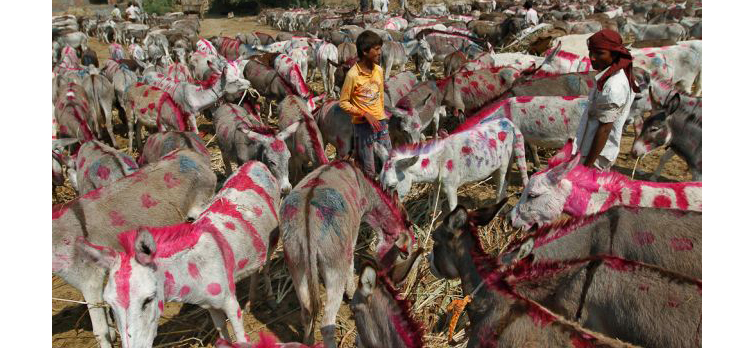
Dedicated to Lord Kartik, the Vautha Mela is one of the major religious events in Gujarat. Although it is on par with the famous Camel Fair in Pushkar… the Vautha Mela in Saptasangam, which is a place of confluence of seven rivers, is yet to reach the countrywide travellers’ minds. The fair is followed by trading of donkeys, usually by the gypsy traders. These donkeys are decorated in various colours that make them the major highlight of the fair.
Time of the year: October/November
Venue: Vautha
30. Minjar Festival, Himachal Pradesh
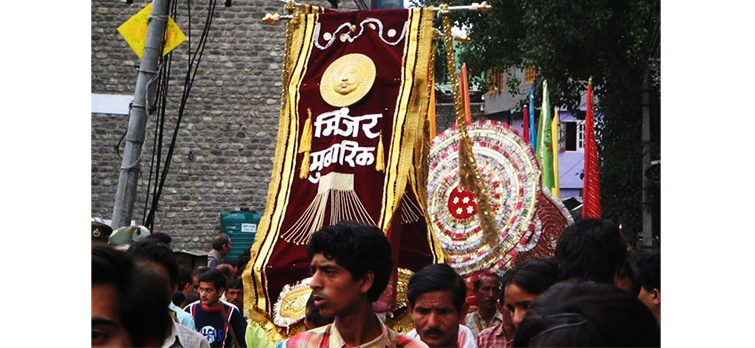
In the midst of the mystic mountains of Himachal Himalayan region… Chamba town livens up the spirit of festivity with great pomp and fanfare during the Minjar festival, which is a 7-day event. It usually commences on the last Sunday of July and continues for seven days. There are several legends associated with this festival. During the event people generally dress up in colourful silk costumes and offer prayers at the Laxmi Narayan temple for a thriving harvesting season. People also indulge in the exchange of gifts, sweets, and money… and the event is followed by a grand procession of Raghuvir Verman idol along with other gods and goddesses who are taken in Palanquins for immersion in the river.
Time of the year: July – August
Venue: Chamba
31. Behdienkhlam, Meghalaya
Popular for hosting various tribal culture, Meghalaya boasts several tribal festivals… of which the Behdienkhlam of the Pnars in the Jaintia Hills remains one of the most uncommon festivals for travellers around the world. The festival is observed to chase away the Demon of Cholera and to seek blessings for a rich harvesting season. The major attractions for a traveller during the Behdienkhlam festival are the unusual ritualistic performances… where young men symbolize the flight of the evil spirit by beating the roof of every house in the village with bamboo poles. Likewise the Dad-lawakor ceremony is another feast for a traveller’s eyes.
Time of the year: June/July
Venue: Jaintia hill region
32. Bani Festival, Andhra Pradesh
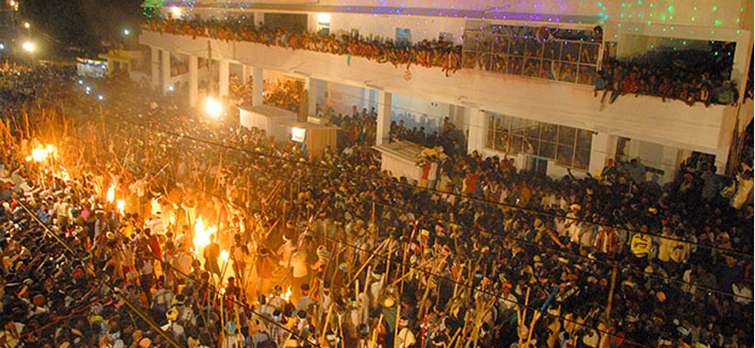
Coming back to another most unusual festival in India… the Bani festival is something beyond any customary observance or practice. During the Dusshera festival lathi-wielding devotees from Karnataka and Andhra Pradesh gather at the Devaragattu Temple in Kurnool to hit each other on the heads to commemorate the killing of a demon by Mala-Malleshwara (Shiva). This event continues till the crack of dawn. I don’t know whether it is going to be an attraction for any traveller to stand and watch the whole ceremony… but once in your lifetime you must check it out.
Time of the year: October/November
Venue: Devaragattu Temple in the Kurnool district
33. Tossing infants from the roof for good luck – Maharashtra and Karnataka
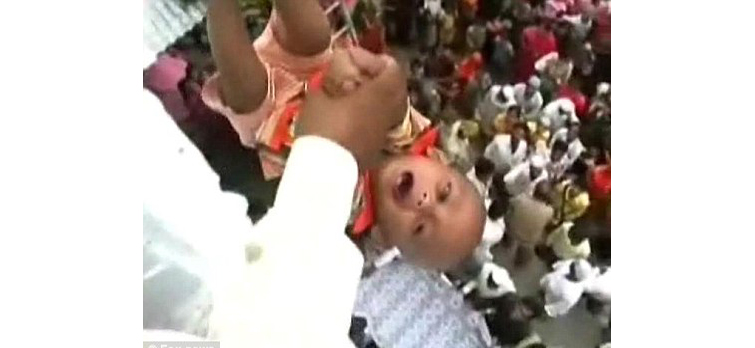
Another unusual event that is again beyond imagination is the tossing of infants from a certain height as people believe doing so brings good luck. It is believed that this ritual is practiced in India for over 700 years by both Hindus and Muslims and can be noticed at the Baba Umer Dargah near Solapur, Maharashtra, and Sri Santeswar temple near India, in the state of Karnataka.
Time of the year: N.A.
Venue: As mentioned above
34. Made Made Snana, Karnataka
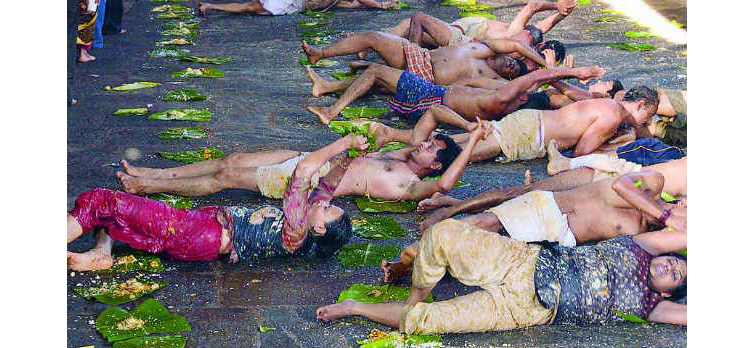
Just after you are done with your meal… imagine if someone rolls over it as a part of the ritual. This practice of rolling over leftover food is witnessed at the Kukke Subramania Temple, which is known as Made Made Snana. This practice is observed by the lower castes people on the food leftovers of Brahmins on banana leaves and is blindly believed that such an act helps the lower castes to get rid of various ailments. This event has been linked with several controversies since 2010.
Time of the year: N.A.
Venue: As mentioned above
35. Animal Weddings – Parts of India
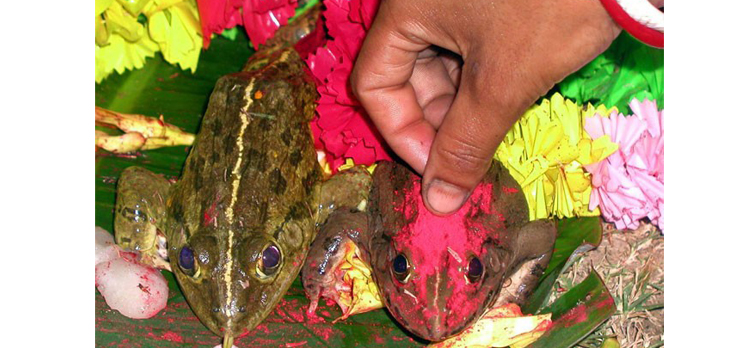
Strange but again this unusual event of Animal Weddings takes place in certain villages in India propitiating the Rain God. You may have witnessed such a ritual if you have visited certain villages across Meghalaya, Maharashtra, Assam, and Karnataka. Wedding of Toads, Dogs, and Donkeys are quite common in such villages.
36. Dhinga Gavar festival, Rajasthan
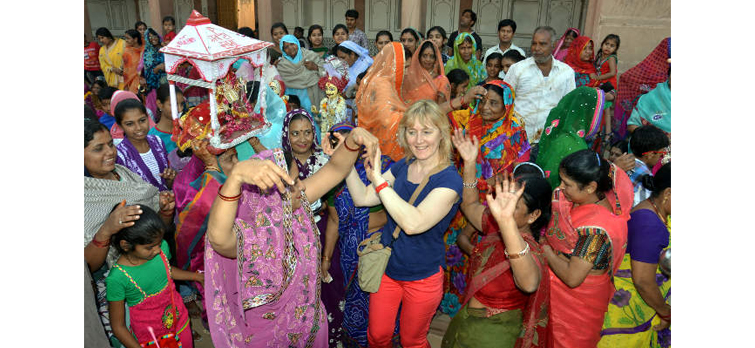
An unusual pick from the incredible and royal land of Rajasthan, the Dhinga Gavar festival is a playful event where the local women dress up in various forms and protect the statues of Dhinga Gavar those which are decorated with gold. It is believed that if an unmarried man can come near to these women and is stricken by the stick gets married soon.
Time of the year: Will be updated soon
Venue: Jodhpur
37. Agni Keli, Karnataka
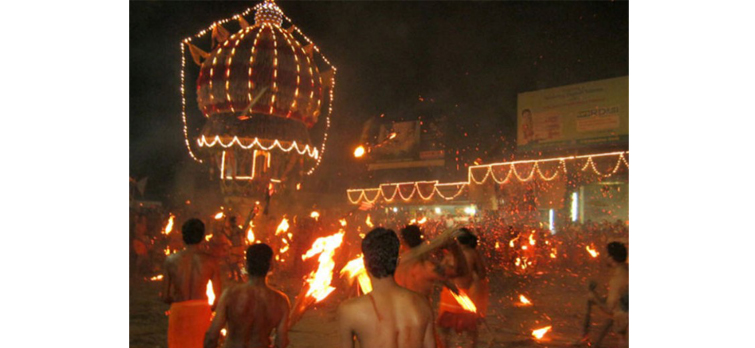
It is a part of the ritual performed during the 8-day festival of Kateel Durga Parameshwari Temple in Mangalore. The traveller has got something interesting to watch here! Hundreds of bare-bodied devotees hurl flaming palm fronds at each other and one who suffers burns are then sprayed with water.
Time of the year: April
Venue: Mangalore
38. Aadi festival, Tamil Nadu
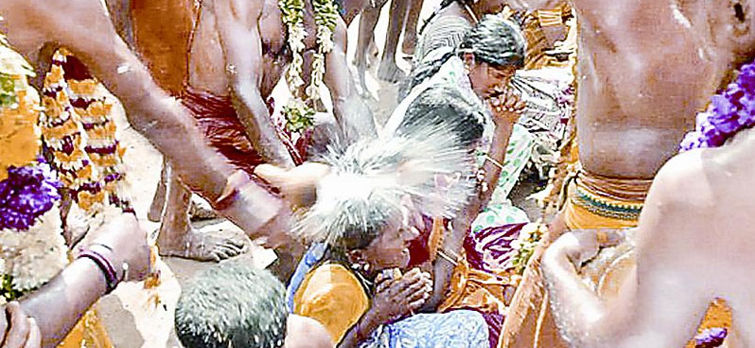
Again think if someone smashes a coconut on his head!!! This ritual is practiced by thousands of devotees at the Mahalakshmi Temple in Karur District of Tamil Nadu. It started during the British Raj when the British placed a deal with the locals against the construction of a railway track across a temple and asked to break stones on their head. The villagers succeeded and thereafter it became a part of a ritual.
Time of the year: July-August
Venue: Karur
39. Ambubachi Mela, Assam
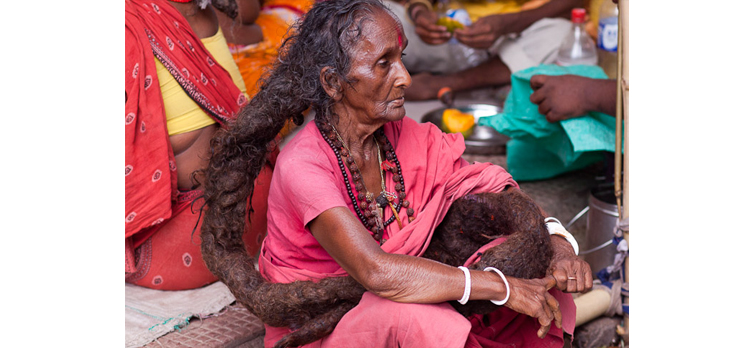
One of the most vibrant religious festivals of North-East India, Ambubachi Mela indicates the celebration of the fertility of Mother Nature. Nilachal Mountain, close to the river Brahmaputra, is the seat of Goddess Kamakhya, the presiding deity of Assam where the goddess menstruates for a period of 3 days. People from all across the country assemble here to take part in this grand festival where they meet hundreds of Sadhus practising Tantrik Rites in the temple premise. The fragrance of Indian Marijuana, camphor, incense sticks create a mystic environment in this holy mountain of Assam.
Time of the year: June
Venue: Kamakhya Temple, Guwahati
40. Gauchar Mela, Uttarakhand
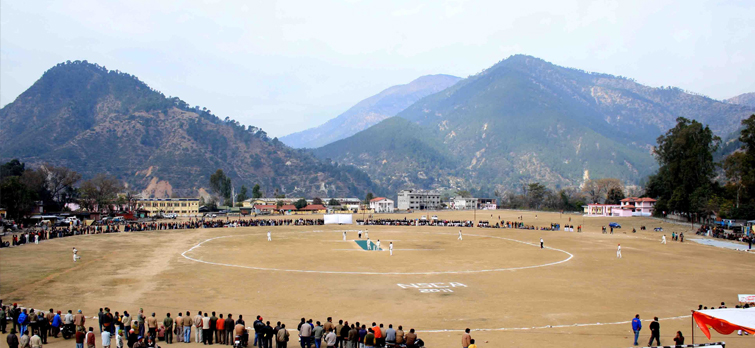
Quite popular amongst the Garhwalis, the Gauchar Mela is a weeklong event in Chamoli district of Uttarakhand. It is an annual event that commences on the 14th of November each year and is a rendezvous of traders, merchants, and is accompanied by cultural dance and music performers. Over the years it has also attracted tourists from different parts of the country. From a traveller’s point of view it is the best time to shop woolen handicrafts made by the Bhotias. One can even visit several other shops and can also indulge in various cultural programs.
Time of the year: November
Venue: Gauchar, Chamoli District
Published: 03 Dec, 2014
Brought up from the cultural capital of India, Kolkata, Swairik Das is a passionate traveller who seeks to travel and explore the length and breadth of the country. He is also a dedicated travel writer, blogger and photographer who by heart is also an adventure freak. His focus is mostly into exploring and writing on trekking, jungle safaris and several adventure activities; religion, festival, heritage, people and cuisine.



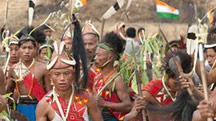 11 Nights / 12 Days
11 Nights / 12 Days 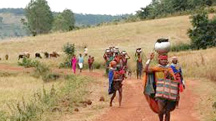 15 Nights / 16 Days
15 Nights / 16 Days 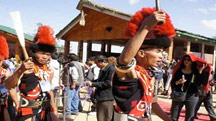 13 Nights / 14 Days
13 Nights / 14 Days 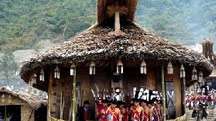 10 Nights / 11 Days
10 Nights / 11 Days 
































